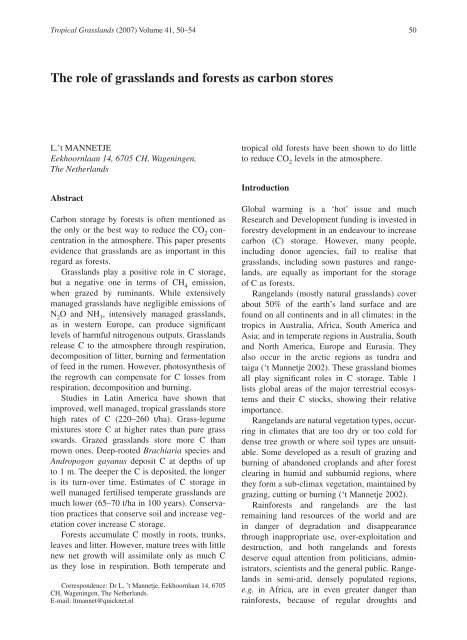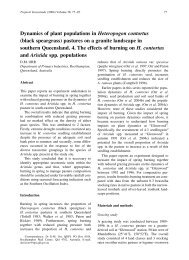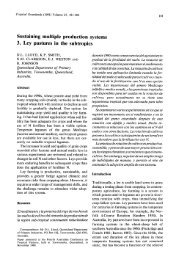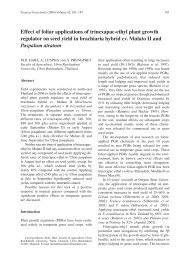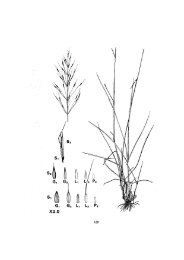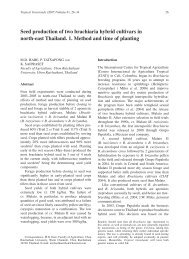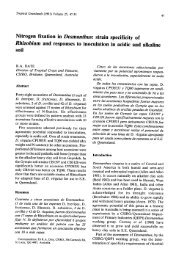The role of grasslands and forests as carbon stores
The role of grasslands and forests as carbon stores
The role of grasslands and forests as carbon stores
You also want an ePaper? Increase the reach of your titles
YUMPU automatically turns print PDFs into web optimized ePapers that Google loves.
Tropical Gr<strong>as</strong>sl<strong>and</strong>s (2007) Volume 41, 50–54 50<br />
<strong>The</strong> <strong>role</strong> <strong>of</strong> <strong>gr<strong>as</strong>sl<strong>and</strong>s</strong> <strong>and</strong> <strong>forests</strong> <strong>as</strong> <strong>carbon</strong> <strong>stores</strong><br />
L.’t MANNETJE<br />
Eekhoornlaan 14, 6705 CH, Wageningen,<br />
<strong>The</strong> Netherl<strong>and</strong>s<br />
Abstract<br />
Carbon storage by <strong>forests</strong> is <strong>of</strong>ten mentioned <strong>as</strong><br />
the only or the best way to reduce the CO 2<br />
concentration<br />
in the atmosphere. This paper presents<br />
evidence that <strong>gr<strong>as</strong>sl<strong>and</strong>s</strong> are <strong>as</strong> important in this<br />
regard <strong>as</strong> <strong>forests</strong>.<br />
Gr<strong>as</strong>sl<strong>and</strong>s play a positive <strong>role</strong> in C storage,<br />
but a negative one in terms <strong>of</strong> CH 4<br />
emission,<br />
when grazed by ruminants. While extensively<br />
managed <strong>gr<strong>as</strong>sl<strong>and</strong>s</strong> have negligible emissions <strong>of</strong><br />
N 2<br />
O <strong>and</strong> NH 3<br />
, intensively managed <strong>gr<strong>as</strong>sl<strong>and</strong>s</strong>,<br />
<strong>as</strong> in western Europe, can produce significant<br />
levels <strong>of</strong> harmful nitrogenous outputs. Gr<strong>as</strong>sl<strong>and</strong>s<br />
rele<strong>as</strong>e C to the atmosphere through respiration,<br />
decomposition <strong>of</strong> litter, burning <strong>and</strong> fermentation<br />
<strong>of</strong> feed in the rumen. However, photosynthesis <strong>of</strong><br />
the regrowth can compensate for C losses from<br />
respiration, decomposition <strong>and</strong> burning.<br />
Studies in Latin America have shown that<br />
improved, well managed, tropical <strong>gr<strong>as</strong>sl<strong>and</strong>s</strong> store<br />
high rates <strong>of</strong> C (220–260 t/ha). Gr<strong>as</strong>s-legume<br />
mixtures store C at higher rates than pure gr<strong>as</strong>s<br />
swards. Grazed <strong>gr<strong>as</strong>sl<strong>and</strong>s</strong> store more C than<br />
mown ones. Deep-rooted Brachiaria species <strong>and</strong><br />
Andropogon gayanus deposit C at depths <strong>of</strong> up<br />
to 1 m. <strong>The</strong> deeper the C is deposited, the longer<br />
is its turn-over time. Estimates <strong>of</strong> C storage in<br />
well managed fertilised temperate <strong>gr<strong>as</strong>sl<strong>and</strong>s</strong> are<br />
much lower (65–70 t/ha in 100 years). Conservation<br />
practices that conserve soil <strong>and</strong> incre<strong>as</strong>e vegetation<br />
cover incre<strong>as</strong>e C storage.<br />
Forests accumulate C mostly in roots, trunks,<br />
leaves <strong>and</strong> litter. However, mature trees with little<br />
new net growth will <strong>as</strong>similate only <strong>as</strong> much C<br />
<strong>as</strong> they lose in respiration. Both temperate <strong>and</strong><br />
Correspondence: Dr L. ’t Mannetje, Eekhoornlaan 14, 6705<br />
CH, Wageningen, <strong>The</strong> Netherl<strong>and</strong>s.<br />
E-mail: ltmannet@quicknet.nl<br />
tropical old <strong>forests</strong> have been shown to do little<br />
to reduce CO 2<br />
levels in the atmosphere.<br />
Introduction<br />
Global warming is a ‘hot’ issue <strong>and</strong> much<br />
Research <strong>and</strong> Development funding is invested in<br />
forestry development in an endeavour to incre<strong>as</strong>e<br />
<strong>carbon</strong> (C) storage. However, many people,<br />
including donor agencies, fail to realise that<br />
<strong>gr<strong>as</strong>sl<strong>and</strong>s</strong>, including sown p<strong>as</strong>tures <strong>and</strong> rangel<strong>and</strong>s,<br />
are equally <strong>as</strong> important for the storage<br />
<strong>of</strong> C <strong>as</strong> <strong>forests</strong>.<br />
Rangel<strong>and</strong>s (mostly natural <strong>gr<strong>as</strong>sl<strong>and</strong>s</strong>) cover<br />
about 50% <strong>of</strong> the earth’s l<strong>and</strong> surface <strong>and</strong> are<br />
found on all continents <strong>and</strong> in all clima tes: in the<br />
tropics in Australia, Africa, South America <strong>and</strong><br />
Asia; <strong>and</strong> in temperate regions in Australia, South<br />
<strong>and</strong> North America, Europe <strong>and</strong> Eur<strong>as</strong>ia. <strong>The</strong>y<br />
also occur in the arctic regions <strong>as</strong> tundra <strong>and</strong><br />
taiga (‘t Mannetje 2002). <strong>The</strong>se gr<strong>as</strong>sl<strong>and</strong> biomes<br />
all play significant <strong>role</strong>s in C storage. Table 1<br />
lists global are<strong>as</strong> <strong>of</strong> the major terrestrial ecosystems<br />
<strong>and</strong> their C stocks, showing their relative<br />
importance.<br />
Rangel<strong>and</strong>s are natural vegetation types, occurring<br />
in climates that are too dry or too cold for<br />
dense tree growth or where soil types are unsuitable.<br />
Some developed <strong>as</strong> a result <strong>of</strong> grazing <strong>and</strong><br />
burning <strong>of</strong> ab<strong>and</strong>oned cropl<strong>and</strong>s <strong>and</strong> after forest<br />
clearing in humid <strong>and</strong> subhumid regions, where<br />
they form a sub-climax vegetation, maintained by<br />
grazing, cutting or burning (‘t Mannetje 2002).<br />
Rainfor ests <strong>and</strong> rangel<strong>and</strong>s are the l<strong>as</strong>t<br />
remaining l<strong>and</strong> resources <strong>of</strong> the world <strong>and</strong> are<br />
in danger <strong>of</strong> degradation <strong>and</strong> disap pearance<br />
through inappropriate use, over-exploitation <strong>and</strong><br />
de struction, <strong>and</strong> both rangel<strong>and</strong>s <strong>and</strong> <strong>forests</strong><br />
deserve equal atten tion from politicians, administrators,<br />
scientists <strong>and</strong> the general public. Rangel<strong>and</strong>s<br />
in semi-arid, densely populated regions,<br />
e.g. in Africa, are in even greater danger than<br />
rain<strong>forests</strong>, because <strong>of</strong> regular droughts <strong>and</strong>
Carbon <strong>stores</strong> in <strong>gr<strong>as</strong>sl<strong>and</strong>s</strong> <strong>and</strong> <strong>forests</strong> 51<br />
Table 1. Global C stocks in vegetation <strong>and</strong> top 1 m <strong>of</strong> soils (Watson et al. 2000).<br />
Biome<br />
Area<br />
(10 6 km 2 )<br />
Carbon stocks (Gt C)<br />
Vegetation Soils Total<br />
Tropical <strong>forests</strong> 17.6 212 216 428<br />
Temperate <strong>forests</strong> 10.4 59 100 159<br />
Boreal <strong>forests</strong> 13.7 88 471 559<br />
Tropical savann<strong>as</strong> 22.5 66 264 330<br />
Temperate <strong>gr<strong>as</strong>sl<strong>and</strong>s</strong> 12.5 9 295 304<br />
Deserts <strong>and</strong> semi-deserts 45.5 8 191 199<br />
Tundra 9.5 6 121 127<br />
Wetl<strong>and</strong>s 3.5 15 225 240<br />
Cropl<strong>and</strong>s 16.0 3 128 131<br />
Total 151.2 466 2011 2477<br />
because they are subject to intense cropping <strong>and</strong><br />
overgrazing, leading to degra dation <strong>and</strong> desertification.<br />
Gr<strong>as</strong>sl<strong>and</strong>s <strong>and</strong> C storage<br />
Gr<strong>as</strong>sl<strong>and</strong> ecosystems have both economic <strong>and</strong><br />
environmental functions, the most important<br />
environmental one being to provide vegetation<br />
cover, protecting the soil <strong>and</strong> ensuring production<br />
<strong>of</strong> feed for animals (wild <strong>and</strong> domesticated),<br />
firewood <strong>and</strong> timber plus other indirect benefits<br />
to the l<strong>and</strong> users. In addition, rangel<strong>and</strong>s contain<br />
medicinal plants <strong>and</strong> germpl<strong>as</strong>m for new <strong>and</strong><br />
wild relatives <strong>of</strong> existing crop <strong>and</strong> p<strong>as</strong>ture plants,<br />
<strong>and</strong> their soils store large quantities <strong>of</strong> C, similar<br />
to those under <strong>forests</strong>.<br />
While gr<strong>as</strong>sl<strong>and</strong> systems play a beneficial<br />
<strong>role</strong> in the storage <strong>of</strong> C, they also have a negative<br />
<strong>role</strong> because <strong>of</strong> the emission <strong>of</strong> CH 4<br />
, mainly<br />
by grazing ruminants. Extensively used rangel<strong>and</strong>s<br />
rele<strong>as</strong>e negligible amounts <strong>of</strong> N 2<br />
O <strong>and</strong><br />
NH 3<br />
because <strong>of</strong> the low levels <strong>of</strong> N in rangel<strong>and</strong><br />
ecosys tems. However, emissions <strong>of</strong> N 2<br />
O <strong>and</strong><br />
NH 3<br />
from intensively managed p<strong>as</strong>tures such <strong>as</strong><br />
in western Europe can reach significant levels<br />
(‘t Mannetje 2002).<br />
Gr<strong>as</strong>sl<strong>and</strong>s also rele<strong>as</strong>e C to the atmosphere<br />
<strong>as</strong> a result <strong>of</strong> respiration, decomposition<br />
<strong>of</strong> litter, burning <strong>and</strong> the fermenta tion <strong>of</strong> feed in<br />
the rumen. Although burning <strong>of</strong> gr<strong>as</strong>sl<strong>and</strong> is a<br />
common practice in the se<strong>as</strong>onally dry tropics,<br />
the total amount <strong>of</strong> C rele<strong>as</strong>ed by burning is <strong>of</strong><br />
the order <strong>of</strong> 4–7 Gt/yr, which is previously stored<br />
C, although this is <strong>of</strong>fset by photosynthesis <strong>of</strong> the<br />
regrowth (Goudriaan 1990; Minami et al. 1993).<br />
Furthermore, if the material w<strong>as</strong> not consumed by<br />
fire, most <strong>of</strong> it would decompose within a year,<br />
rele<strong>as</strong>ing the same amount <strong>of</strong> C to the atmosphere<br />
(Hall <strong>and</strong> Scurlock 1991). In a study covering<br />
the whole <strong>of</strong> Australia over a period <strong>of</strong> 18 years,<br />
Graetz (2002) concluded that the annual C emissions<br />
from gr<strong>as</strong>sl<strong>and</strong> <strong>and</strong> clearing fires are recaptured<br />
by C uptake <strong>as</strong> a result <strong>of</strong> regrowth, usually<br />
within a year. Annually, the C emitted from gr<strong>as</strong>s<br />
fires throughout Australia is just 5% <strong>of</strong> the uptake<br />
<strong>of</strong> 5.97 Gt C in regrowth. Repeated bur ning <strong>of</strong><br />
wooded savann<strong>as</strong> actually incre<strong>as</strong>es the C content<br />
<strong>of</strong> the soil, because every year a fraction <strong>of</strong> the<br />
wood, which is burned, is converted to charcoal,<br />
which is very stable C (Minami et al. 1993).<br />
<strong>The</strong> introduction <strong>of</strong> improved gr<strong>as</strong>ses <strong>and</strong><br />
legumes to rangel<strong>and</strong>s will improve production<br />
<strong>and</strong> also incre<strong>as</strong>e the C-storage potential compared<br />
with the native savann<strong>as</strong>. In the llanos<br />
<strong>of</strong> Colombia, Fisher et al. (1994) me<strong>as</strong>ured C<br />
storage <strong>of</strong> 237 t/ha under a 6-year-old Andropogon<br />
gayanus-Stylosanthes capitata p<strong>as</strong>ture,<br />
with about half <strong>of</strong> it in the 40–100 cm deep soil<br />
layer, compared with 186 t/ha under unimproved<br />
savanna. At another site, the soil under unimproved<br />
savanna held 197 t/ha C, compared with<br />
223 t/ha under Brachiaria humidicola alone <strong>and</strong><br />
268 t/ha under a B. humidicola-Arachis pintoi<br />
p<strong>as</strong>ture. Comparable levels <strong>of</strong> C sequestration<br />
have been me<strong>as</strong>ured by Ayarza et al. (1987), Tarré<br />
et al. (2001) <strong>and</strong> Boddey et al. (2002). <strong>The</strong> deposition<br />
<strong>of</strong> C at depth can be explained by the m<strong>as</strong>sive<br />
root systems <strong>and</strong> deep-rootedness <strong>of</strong> tropical<br />
gr<strong>as</strong>ses, which <strong>of</strong>ten extend to more than 1 m<br />
depth (Ayarza et al. 1993; Fisher et al. 1994).<br />
Van den Pol-van D<strong>as</strong>selaar <strong>and</strong> Lantinga<br />
(1995) reported C sequestration rates in<br />
the top 25 cm <strong>of</strong> soil <strong>of</strong> 6.5 t/ha/yr in mown<br />
<strong>and</strong> 8.7 t/ha/yr in grazed permanent temperate
52 L.’t Mannetje<br />
<strong>gr<strong>as</strong>sl<strong>and</strong>s</strong> in <strong>The</strong> Netherl<strong>and</strong>s, receiving<br />
100–250 kg N/ha/yr. C sequestration decre<strong>as</strong>ed<br />
at higher N fertiliser rates. With the use <strong>of</strong> modelling,<br />
long-term organic soil C under mown<br />
<strong>and</strong> grazed <strong>gr<strong>as</strong>sl<strong>and</strong>s</strong> w<strong>as</strong> estimated at 65 <strong>and</strong><br />
72 t/ha, respectively, over 100 years.<br />
Follett et al. (2003) me<strong>as</strong>ured soil organic 14 C<br />
activity <strong>and</strong> used radio<strong>carbon</strong> dating to determine<br />
how long soil C had been sequestered in the soil<br />
<strong>of</strong> historic prairie l<strong>and</strong>s in the USA. Nearly onehalf<br />
<strong>of</strong> the total weight <strong>of</strong> soil organic C w<strong>as</strong> in<br />
the top 20 cm <strong>and</strong> up to one-third in the top 10 cm<br />
<strong>of</strong> the soil. <strong>The</strong> remainder w<strong>as</strong> located from 20 to<br />
200 cm below the surface, <strong>and</strong> soil organic C in<br />
the top 2 m <strong>of</strong> soil amounted to 85–150 t/ha. Soil<br />
organic C that is stored below 20 cm h<strong>as</strong> mean<br />
residence times <strong>of</strong> 1 000–2 000 years. While soil<br />
C at depths <strong>of</strong> about 2 m h<strong>as</strong> mean residence<br />
times <strong>of</strong> 9 000–13 000 years, it accounts for only<br />
about 5% <strong>of</strong> the total (Follett et al. 2003).<br />
Effects <strong>of</strong> gr<strong>as</strong>sl<strong>and</strong> management on<br />
soil C storage<br />
Follett <strong>and</strong> Schuman (2005) reviewed the impacts<br />
<strong>of</strong> climatic <strong>and</strong> management factors on rate <strong>of</strong><br />
C accumulation <strong>and</strong> long-term C storage in the<br />
USA. <strong>The</strong>y found that fertilisation, gr<strong>as</strong>sl<strong>and</strong><br />
improvement <strong>and</strong> proper grazing could result in<br />
the sequestration <strong>of</strong> 10.5–34.3 Mt <strong>of</strong> C annually.<br />
About half <strong>of</strong> these amounts could be attributed<br />
to improved management <strong>of</strong> rangel<strong>and</strong>s. More<br />
soil C is generally stored under grazing than<br />
under cutting.<br />
Conservation practices that conserve soil <strong>and</strong><br />
incre<strong>as</strong>e vegetation cover also incre<strong>as</strong>e C storage.<br />
Gavenda et al. (2000) listed the following me<strong>as</strong>ures<br />
<strong>as</strong> being important for C sequestration:<br />
• Installing permanent vegetation buffers,<br />
such <strong>as</strong> windbreaks, contour hedgerows, <strong>and</strong><br />
riparian buffers,<br />
• Converting marginal agricultural l<strong>and</strong> to<br />
perennial gr<strong>as</strong>sl<strong>and</strong> or forest,<br />
• Using conservation or no-till cultivation<br />
systems,<br />
• Incre<strong>as</strong>ing fertiliser <strong>and</strong> water use efficiency,<br />
• Incre<strong>as</strong>ing cropping intensity,<br />
• Managing woodl<strong>and</strong>s to conserve soils <strong>and</strong><br />
incre<strong>as</strong>e biom<strong>as</strong>s,<br />
• Incorporating trees into agricultural operations<br />
through agr<strong>of</strong>orestry, <strong>and</strong><br />
• Using cover crops.<br />
Soil erosion is a major cause <strong>of</strong> soil organic<br />
C loss <strong>and</strong> incre<strong>as</strong>ing greenhouse g<strong>as</strong> emissions.<br />
This takes place by:<br />
• Exposing C retained within soil aggregates,<br />
• Mineralising C by oxidation <strong>and</strong> microbial<br />
processes, <strong>and</strong><br />
• Decre<strong>as</strong>ing the soil’s ability to support vegetation<br />
by lowering soil fertility, losing water <strong>as</strong><br />
run<strong>of</strong>f, decre<strong>as</strong>ing plant-available soil water,<br />
burying or flooding crops <strong>and</strong> other erosionrelated<br />
effects.<br />
However, soil organic C under p<strong>as</strong>ture is also<br />
subject to change, depending on the age, nutritional<br />
status <strong>and</strong> condition <strong>of</strong> the vegetation.<br />
Asner et al. (2004) concluded that:<br />
• Above-ground <strong>and</strong> soil C stocks decre<strong>as</strong>ed<br />
with p<strong>as</strong>ture age on both clayey <strong>and</strong> s<strong>and</strong>y<br />
soils,<br />
• Declines in plant biom<strong>as</strong>s were well correlated<br />
with declines in soil C <strong>and</strong> with available<br />
phosphorus (P) <strong>and</strong> calcium (Ca), <strong>and</strong><br />
• Despite low initial values for total <strong>and</strong><br />
available soil P, ecosystem P stocks declined<br />
with p<strong>as</strong>ture age, <strong>as</strong> did a number <strong>of</strong> other<br />
nutrients.<br />
C dynamics <strong>of</strong> <strong>forests</strong><br />
<strong>The</strong>re is much misunderst<strong>and</strong>ing about the C<br />
economy <strong>of</strong> <strong>forests</strong>. Many people are <strong>of</strong> the<br />
(uninformed) opinion that forest preservation<br />
<strong>and</strong> planting <strong>of</strong> new <strong>forests</strong> are the most effective<br />
or only ways to accumulate C in terrestrial<br />
ecosystems. <strong>The</strong> Dutch FACE Foundation (1998)<br />
is primarily undertaking afforestation, reforestation<br />
or forest restoration <strong>and</strong> funding forestry<br />
research to me<strong>as</strong>ure C sequestration in many<br />
countries.<br />
Forests accumulate C mostly in roots, trunks,<br />
leaves <strong>and</strong> litter. However, once trees are mature<br />
<strong>and</strong> have little or no growth, they will <strong>as</strong>similate<br />
only <strong>as</strong> much C <strong>as</strong> they lose in respiration.<br />
Clark (2002) reviewed scientific literature about<br />
biom<strong>as</strong>s changes in old-growth neo-tropical <strong>forests</strong>.<br />
She concluded that such tropical <strong>forests</strong><br />
were not accumulating substantial amounts <strong>of</strong> C<br />
in the form <strong>of</strong> net biom<strong>as</strong>s incre<strong>as</strong>es. Hoch et al.<br />
(2003) postulated that mature trees in temperate<br />
<strong>forests</strong> might not <strong>of</strong>fset global warming by mopping<br />
up excess C. <strong>The</strong>y tested the <strong>as</strong>sumption that<br />
current atmospheric C levels limit photosynthesis<br />
<strong>and</strong> growth <strong>and</strong> thus do not add to C storage.
Carbon <strong>stores</strong> in <strong>gr<strong>as</strong>sl<strong>and</strong>s</strong> <strong>and</strong> <strong>forests</strong> 53<br />
During spring, when trees develop new leaves,<br />
deciduous trees rely heavily on C reservoirs <strong>of</strong><br />
sugars, starches <strong>and</strong> fats, because atmospheric C<br />
is insufficient. Furthermore, limited supplies <strong>of</strong><br />
other nutrients, particularly N <strong>and</strong> P, may limit<br />
<strong>as</strong>similation <strong>and</strong> growth. Nevertheless, clearing<br />
forest leads to a great loss <strong>of</strong> C from the biom<strong>as</strong>s<br />
to the atmosphere, which cannot be replaced by<br />
gr<strong>as</strong>sl<strong>and</strong> C sequestration in the short term.<br />
Richey et al. (2002) concluded that considerable<br />
C emissions to the atmosphere take place in<br />
forest systems in the humid tropics <strong>as</strong> a result <strong>of</strong><br />
decaying litter <strong>and</strong> decomposing soil organic C<br />
<strong>and</strong> that rivers in humid forested ecosystems, like<br />
Amazonia, are C-saturated <strong>and</strong> add to atmospheric<br />
C. Detailed studies by Mayorga et al. (2005) supported<br />
this conclusion, suggesting that the C w<strong>as</strong><br />
derived from existing vegetation, not from ancient<br />
deposits. <strong>The</strong>y concluded that Amazonia w<strong>as</strong>, at<br />
best, in equilibrium with the atmosphere regarding<br />
C, <strong>and</strong> possibly even added to atmospheric C.<br />
Deforestation is carried out for arable cropping<br />
<strong>and</strong> for gr<strong>as</strong>sl<strong>and</strong> establishment. Arable l<strong>and</strong><br />
<strong>stores</strong> little C in the soil in contr<strong>as</strong>t with <strong>gr<strong>as</strong>sl<strong>and</strong>s</strong><br />
(Detwiler 1986). Ibrahim (1994) me<strong>as</strong>ured<br />
47 t/ha C in the top 10 cm <strong>of</strong> soil under grazed<br />
B. brizantha – A. pintoi p<strong>as</strong>tures, which had been<br />
established 3 years previously, in the Atlantic<br />
Zone <strong>of</strong> Costa Rica. This amount <strong>of</strong> soil C w<strong>as</strong><br />
comparable with that found under the original<br />
rainforest. While well managed p<strong>as</strong>tures can accumulate<br />
C in the soil under them, they are unlikely<br />
to replace the above-ground C lost when the<br />
forest is cleared. <strong>The</strong>refore, some loss <strong>of</strong> stored<br />
C to the atmosphere is to be expected following<br />
deforestation, when the l<strong>and</strong> is sown to gr<strong>as</strong>sl<strong>and</strong>.<br />
<strong>The</strong> permanent de struction <strong>of</strong> range l<strong>and</strong>s by cultiva<br />
tion <strong>and</strong> desertification, however, is usually<br />
irreversible <strong>and</strong> results in a significant addition to<br />
atmospheric C from ter restrial sources.<br />
Acknowledgements<br />
I am indebted to Dr M.J. Fisher, CIAT, Colombia<br />
for useful suggestions he made for improving the<br />
manuscript.<br />
References<br />
ASNER, G.P.W., TOWNSEND, A.R., BUSTAMANTE, M.M.C.,<br />
N ARDOTO, G.B. <strong>and</strong> OLANDER. L.P. (2004) P<strong>as</strong>ture degradation<br />
in the central Amazon: linking changes in C <strong>and</strong> nutrient<br />
cycling with remote sensing. Global Change Biology, 10,<br />
844–862.<br />
AYARZA, M.A., DEXTRE, R., ARA, M., SCHAUS, R., REATEGUI, K.<br />
<strong>and</strong> SANCHEZ, P.A. (1987) Produccion animal y cambios en la<br />
fertilidad del suelo en cinco <strong>as</strong>ociaciones bajo p<strong>as</strong>toreo en un<br />
Ultisol de Yurimagu<strong>as</strong>. Suelos Ecuatoriales, 18, 204–208.<br />
AYARZA, M.A., RAO, I.M., THOMAS, R.J., FISHER, M.J., LASCANO,<br />
C.E. <strong>and</strong> HERRERA, P. (1993) St<strong>and</strong>ing root biom<strong>as</strong>s <strong>and</strong> root<br />
distribution in Brachiaria decumbens-Arachis pintoi p<strong>as</strong>tures<br />
under grazing. Proceedings <strong>of</strong> the XVII International<br />
Gr<strong>as</strong>sl<strong>and</strong> Congress, Palmerston North, New Zeal<strong>and</strong> <strong>and</strong><br />
Rockhampton, Australia, 8–21 February 1993. 3, 1921–1923.<br />
BODDEY, R.M., URQUIAGA, S., ALVES, B.J.R. <strong>and</strong> FISHER, M.J.<br />
(2002) Potential for C Accumulation under Brachiaria<br />
P<strong>as</strong>tures. In: Kimble, J. M., Lal, R. <strong>and</strong> Follett, R. F. (eds)<br />
Agricultural Practices <strong>and</strong> Policies for C Sequestration in<br />
Soil. pp. 395–408. (Lewis Publishers; CRC Press Company:<br />
Boca Raton).<br />
CLARK, D.A. (2002) Are tropical <strong>forests</strong> an important <strong>carbon</strong><br />
sink? Re-analysis <strong>of</strong> the long-term plot data. Ecological<br />
Applications, 12, 3–7.<br />
DETWILER, R.P. (1986) L<strong>and</strong> use change <strong>and</strong> the global C cycle:<br />
the <strong>role</strong> <strong>of</strong> tropical soils. Biogeochemistry, 2, 67–93.<br />
FACE Foundation (1998) http://www.stichtingface.nl/.<br />
FISHER, M.J., RAO, I.M., AYARZA, M.A., LASCANO, C.E.,<br />
SANZ, J.I., THOMAS, R.J. <strong>and</strong> VERA, R.R. (1994) C storage<br />
by introduced deep-rooted gr<strong>as</strong>ses in the South American<br />
savann<strong>as</strong>. Nature, London, 371, 236–238.<br />
FOLLETT, R.F., LEAVITT, S.W., KIMBLE, J.M. <strong>and</strong> PRUESSNER, E.G.<br />
(2003) Paleoenvironmental inferences from δ 13 C <strong>of</strong> soil<br />
organic C in 14 C-dated pr<strong>of</strong>iles in the U.S. Great Plains. XVI<br />
INQUA Congress, Reno, NV, 23–30 July, 2003.<br />
FOLLETT, R.F. <strong>and</strong> SCHUMAN, G.E. (2005) Grazing l<strong>and</strong> contribution<br />
to C sequestration. In: McGilloway, D.A. (ed.)<br />
Gr<strong>as</strong>sl<strong>and</strong>: A Global Resource. Proceedings <strong>of</strong> the XX<br />
International Gr<strong>as</strong>sl<strong>and</strong> Congress, Dublin, Irel<strong>and</strong>,<br />
26 June–1 July 2005. pp. 265–277. (Wageningen Academic<br />
Publishers: Wageningen, <strong>The</strong> Netherl<strong>and</strong>s).<br />
GAVENDA, R., ELEVITCH, C.R. <strong>and</strong> WILKINSON, K.M. (2000)<br />
C Sequestration. <strong>The</strong> Overstory #66 (htp://www.agr<strong>of</strong>orestry.net/overstory).<br />
GOUDRIAAN, J. (1990) Atmospheric C, global C fluxes <strong>and</strong><br />
the biosphere. In: Rabbinge, R., Goudriaan, J., Keulen, H.<br />
van, Penning de Vries, F.W.T. <strong>and</strong> Laar, H.H. van (eds)<br />
<strong>The</strong>oretical Production Ecology: Refl ections <strong>and</strong> Prospects.<br />
Simulation Monographs 34. pp. 17–40. (PUDOC:<br />
Wageningen, <strong>The</strong> Netherl<strong>and</strong>s).<br />
GRAETZ, R.D. (2002) <strong>The</strong> net C dioxide flux from biom<strong>as</strong>s<br />
burning on the Australian continent [Electronic publication].<br />
Aspendale: CSIRO Atmospheric Research. CSIRO Atmospheric<br />
Research Technical Paper No. 61.<br />
HALL, D.O. <strong>and</strong> SCURLOCK, J.M.O. (1991) Climate change <strong>and</strong><br />
productivity <strong>of</strong> natural <strong>gr<strong>as</strong>sl<strong>and</strong>s</strong>. Annals <strong>of</strong> Botany, 67<br />
(Suppl.1), 49–55.<br />
HOCH, G., RICHTER, A. <strong>and</strong> KÖRNER, C. (2003) Non-structural<br />
C compounds in temperate forest trees. Plant, Cell <strong>and</strong><br />
Environment, 26,1067–1081.<br />
IBRAHIM, M.A. (1994) Compatibility, persistence <strong>and</strong><br />
productivity <strong>of</strong> gr<strong>as</strong>s-legume mixtures for sustainable<br />
animal production in the Atlantic Zone <strong>of</strong> Costa Rica.<br />
Doctoral <strong>The</strong>sis. Agricultural University, Wageningen,<br />
<strong>The</strong> Netherl<strong>and</strong>s.<br />
MANNETJE, L.’T (2002) Advances in gr<strong>as</strong>sl<strong>and</strong> science.<br />
Netherl<strong>and</strong>s Journal <strong>of</strong> Agricultural Science, 50, 195–221.<br />
MAYORGA, E., AUFDENKAMPE, A.K., MASIELLO, C.A., KRUSCHE,<br />
A.V., HEDGES, J.I., QUAY, P.D., RICHEY, J.E. <strong>and</strong> BROWN, T.A.<br />
(2005) Respiration <strong>of</strong> contemporary organic matter drives outg<strong>as</strong>sing<br />
<strong>of</strong> C from Amazonian rivers. Nature, 436, 538–540.<br />
MINAMI, K., GOUDRIAAN, J., LANTINGA, E.A. <strong>and</strong> KIMURA, T.<br />
(1993) Significance <strong>of</strong> <strong>gr<strong>as</strong>sl<strong>and</strong>s</strong> in emission <strong>and</strong> absorption<br />
<strong>of</strong> greenhouse g<strong>as</strong>es. Proceedings <strong>of</strong> the XVII International<br />
Gr<strong>as</strong>sl<strong>and</strong> Congress, Palmerston North, New Zeal<strong>and</strong> <strong>and</strong><br />
Rockhampton, Australia, 8–21 February 1993. 2, 1231–1238.
54 L.’t Mannetje<br />
RICHEY, J.E., MELACK, J.M., AUFDENKAMPE, A.K. <strong>and</strong><br />
B ALLESTER, V.M. (2002) Outg<strong>as</strong>sing from Amazonian rivers<br />
<strong>and</strong> wetl<strong>and</strong>s <strong>as</strong> a large tropical source <strong>of</strong> atmospheric CO 2<br />
.<br />
Nature, 416, 617–620.<br />
TARRÉ, R.M., MACEDO, R., CANTARUTTI, R.B., REZENDE, C.P.,<br />
PEREIRA, J.M., FERREIRA, E., ALVES, B.J.R., URQUIAGA, S. <strong>and</strong><br />
BODDEY, R.M. (2001) <strong>The</strong> effect <strong>of</strong> the presence <strong>of</strong> a forage<br />
legume on nitrogen <strong>and</strong> C levels in soils under Brachiaria<br />
p<strong>as</strong>tures in the Atlantic forest region <strong>of</strong> the South <strong>of</strong> Bahia,<br />
Brazil. Plant <strong>and</strong> Soil, 234, 15–26.<br />
VAN DEN POL-VAN DASSELAAR, A. <strong>and</strong> LANTINGA, E.A. (1995)<br />
Modelling the C cycle <strong>of</strong> gr<strong>as</strong>sl<strong>and</strong> in the Netherl<strong>and</strong>s<br />
under various management strategies <strong>and</strong> environmental<br />
conditions. Netherl<strong>and</strong>s Journal <strong>of</strong> Agricultural Science, 43,<br />
183–194.<br />
WATSON, R.T., NOBLE, I.R., BOLIN, B., RAVINDRANAHT, N.H.,<br />
VERARDO, D.J. <strong>and</strong> DEKKEN, D.J. (eds) L<strong>and</strong> use, L<strong>and</strong> Use<br />
change <strong>and</strong> Forestry: A Special Report <strong>of</strong> the Intergovernmental<br />
Panel on Climate Change. (Cambridge University<br />
Press: Cambridge, UK).<br />
(Received for publication April 25, 2006; accepted December 19, 2006)


